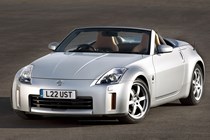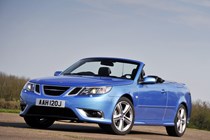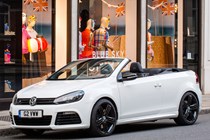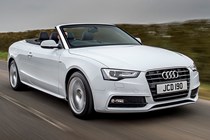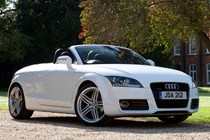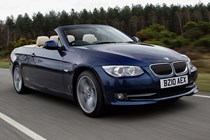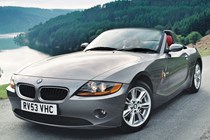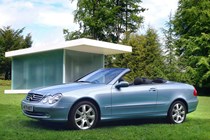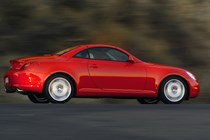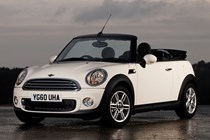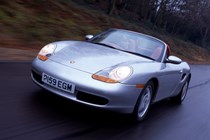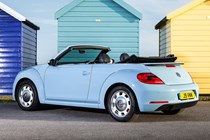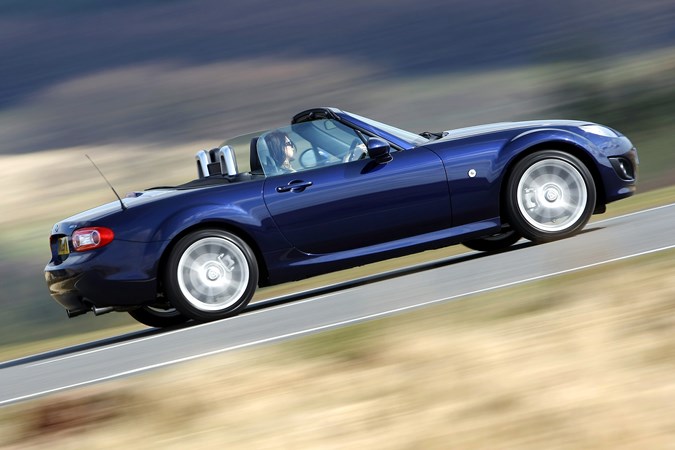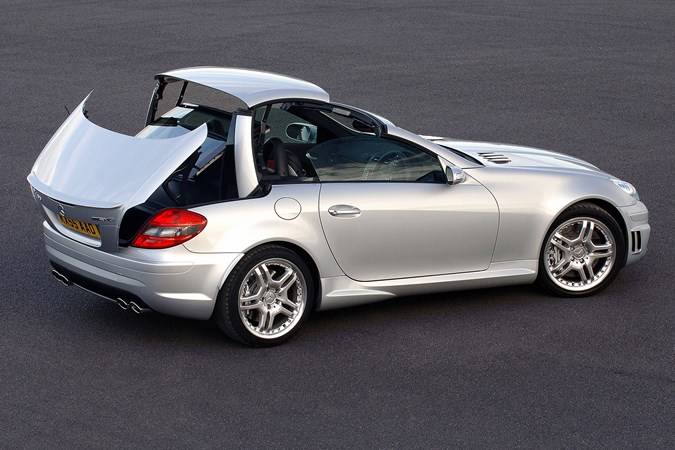Buying a used convertible makes good sense no matter what the time of year you choose to take the plunge. In the winter slow sales mean low prices, so bargains can be had. In the summer, the supply is low as people are out in the cars – and you can enjoy your new purchase right away. This list will point you in the direction of the best used cars to choose from for less than £10,000.
If you love the feeling of wind in your hair, it doesn’t get much better than buying a used convertible car. There’s a broad choice of styles, from sensible four-seaters to small, sporty, driver-focused two seaters. Unlike the new car market, where you’re limited to choosing from a few good convertibles available that year, you can go crate-digging for every manufacturer’s greatest hits over the past 75 years, potentially.
Britain loves open-air motoring, too. The UK is Europe’s second largest market for convertibles. It rains up to 200 days per year, but the sheer number of ragtops available proves Brits like to make the most of the sun when it does make an appearance. The good news is that if you read on, you’ll find we have plenty of convertible-specific info to add to our tips for buying a used car.
Scroll down to discover our pick of the best used cars in the UK – and what to look for when buying.
Best used convertibles in 2024
We’ve broken this list into two groups – two-seaters, often referred to as roadsters, and four-seaters which offer a more relaxed experience but with room for friends or family (or a bit more shopping). Most modern four-seater convertibles have Isofix points to support child seats, and include active roll-over protection features making them much safer than classic alternatives.
Much improved over the original, with a wide choice of engines
Engines are generally reliable, with massive specialist support, although we’d favour the tuneable 2.0-litre petrol over the out-of-fashion diesel. Quattro models don’t harbour any hidden horrors, although you need to make sure that they’ve been properly serviced. We’d steer clear of DSG automatic models unless they’re very well documented. Overall, a great choice if you take time to seek out the best examples, although you’ll pay a (worthwhile) premium.
Read our full Audi TT Roadster Mk2 review
Pros
- Superb interior is ageing well
- Hood folds and opens very quickly
- Wide choice of efficient engines
Cons
- Can be very expensive to repair
- Some early DSG reliability issues
Quirky styling, great driving experience
The 2.0-litre motor that replaced the 2.2 may not be as powerful but it’s more pleasant to use. A facelift in 2006 increased engine power and performance, with these models denoted by their ‘si’ badging. Every Z4 loves corners and has direct steering to engage the driver fully in the process. Sniffing out a car with several optional extras is a great way to get good value for money when buying a secondhand convertible.
Read our full BMW Z4 Roadster review
Pros
- Six-cylinder performance
- Balanced handling, nice steering
- Fast, unobtrusive folding hardtop
Cons
- Entry-level cars disappointing
- Reliability isn’t stellar
Now emerged from the shadow of the 911 as a modern classic in its own right
Best of all, instead of paying £20k for a well-used 911, you can get usable early 1996-on Boxsters from less than £4,000, and running projects can be less than £3,000 – though how long they run may be a gamble.
There are some well-known issues you need to be aware of, but experts are easily able to fix them these days – if the issues haven’t already been sorted. History tells us affordable Porsches don’t stay affordable forever, so now is the best time to buy a Boxster before its modern classic status starts to become more widely celebrated.
Read our full Porsche Boxster Roadster review
Pros
- Fabulous steering
- Brilliant handling
- Boxster S has vivid acceleration
Cons
- Servicing and parts are costly
- Standard Boxster isn’t particularly quick
In its third-generation, the MX-5 was as brilliant as ever…
You still need to check for rust, of course – even these aren’t immune. But there’s less likelihood of it being terminal, and there are still plenty of well cared-for cars out there that remain pretty much immaculate. We like the 2.0-litre Sport, because it has 160hp power, a slick six-speed gearbox and a limited-slip differential for even more tenacious handling. But any MX-5 is a refreshingly purist joy to drive.
Read our full Mazda MX-5 Convertible review
Pros
- Stylish and great fun to drive
- Folding hard top option worthwhile
- Superb value for money
Cons
- Can hide rust very well
- Not particularly economical
Two seater with added refinement when driving with the roof up
The good news is that the SLK (R171) is fundamentally reliable and less prone to ugly, visible rust (unlike the original 1996-2004 Mercedes SLK). Rear subframes are a weak spot, though Mercedes has replaced many on cars with good service records. It suffers from a few well-known and documented issues that specialists are happy to put right. Parts prices can be pricey for SLK-specific trim and electrical components, but overall, it should be cheap to run. However, the V6 and AMG models are heavy on fuel and costly to insure.
Read our full Mercedes-Benz SLK Roadster review
Pros
- V6 models are fast and refined
- Eye-catching looks, compact size
- Better-built than predecessor
Cons
- Some problems are very expensive to sort
- Indifferent performance from entry-level models
Sharp, rear-wheel drive thrills, and brilliant reliability
The ride is firm but not jarring, and refinement in the cabin is acceptable with the roof down, but you may need to shout to be heard at motorway speeds. The standard 350Z Roadster is well equipped, but we’d go for the GT Pack that additionally benefits from heated and electrically adjusted seats, leather upholstery, cruise control and Bose stereo system. Plus its forged alloy wheels look great, too.
Read our full Nissan 350Z Roadster review
Pros
- Great engine, strong performance
- Well-priced compared with rivals
- Excellent mechanical reliability
Cons
- It’s heavy on fuel, costly to tax
- Beware badly modified versions
The grown-up choice for your money
Early models suffer problems with timing chain wear. Higher mileage cars with a poor history of oil changes should be avoided, too. Watch out for oil consumption on early models, misfiring on V6s, and timing chain noise on the 4.2-litre V8. We recommend any of the 2.0-litre TFSI models – they’re quick enough, economical on long runs, and easy to maintain. As they use so many shared Volkswagen Group parts, a good specialist won’t have any issues maintaining one fo you.
Read our full Audi A5 Cabriolet review
Pros
- Elegant, sporty design
- Refined to drive
- Decent room for four
Cons
- Most models for sale are diesel
- Parts prices can be expensive
Quality and refinement for a bargain price – if bought with care
Part of the appeal comes from the smooth, luxurious CLK 320 with a robust, and usually ULEZ-compliant, petrol V6, but the 1.8-litre 200K is hardly slow, thanks to Mercedes’ proven supercharged boost. An excellent driving position, and warm, sophisticated soft-top roof ensure the CLK is good to drive year-round. Watch out for rust – scabby arches are common, but it’s the spring perches and subframe mounts you want to focus on.
Read our full Mercedes-Benz CLK Cabriolet review
Pros
- One of the cheapest open-topped cars
- Relaxed cruising, smooth V6 petrol
- Still feels upmarket
Cons
- Rust can be a concern
- Trim and electrical issues common
Four-seater convertible for those who want a folding hardtop
The E90-generation BMW 3 Series did see some cost-cutting compared with older models, and that’s translated into long-term reliability issues. The popular 2.0-litre 320d model has a design fault with its camshaft sprocket that damages camchains on cars skimped on oil changes, while the brilliant 335i can suffer from high-pressure fuel pump failures. Finally, water ingress into the boot can get to the hood motor which leads to failure.
Read our full BMW 3 Series Convertible review
Pros
- It’s a 3 Series, so it’s great to drive
- Excellent engine line-up
- Economy or performance – you choose
Cons
- BMW diesels of this era have issues
- When that amazing roof goes wrong, it’s tough to fix
Retro-styled Veedub that’s looking better with age
Not sure what engine to choose? A suite of seven engines was offered. The entry level engine was a 1.2-litre TSI petrol with 110hp but a low-emissions version with VW’s BlueMotion Technology was also available. Then there was a 160hp 1.4-litre TSI petrol and a 200hp 2.0-litre version. Still not sure? How about a 1.6-litre TDI with 105hp or a 2.0-litre TDI with 140hp. All are good, all had their earlier reliability issues sorted – in a car with arguably more fun appeal than the Golf it’s based on.
Read our full Volkswagen Beetle Cabriolet review
Pros
- It’s mainly a Golf underneath
- Stand-out design
- Great engine line-up
Cons
- Not exactly a comfortable ride
- Less practical than a Golf Cabrio
Left-field V8 powered cruiser for those who think differently
But hold your horses for a second – because the SC430 has a lot of positive points. Firstly, it’s beautifully, gloriously built, and is packed with kit. The metal folding roof means that the SC430 is just as good as a coupe in the winter. There’s minimal wind or road noise thanks to excellent sound insulation while even with the roof down it still feels superbly refined with little buffeting. All that holds it back is the odd styling and huge thirst.
Read our full Lexus SC Roadster review
Pros
- Silky-smooth V8 engine
- Beautifully-built inside and out
- Balletic folding hardtop
Cons
- It chews through petrol
- Not exactly fun on a B-road
Fun to drive, sized for cities, and a great image
As a used car, the MINI Convertible suffers from a few drawbacks, not least the Cooper S models’ well-documented engine ‘death rattle’ caused by a failure of the camshaft chain tensioner. Specialists fix lots of them, but it’s still costly to sort – better buy one that’s already been done. Other issues are less scary and include more general wear and tear problems, reflecting the car’s excellent build quality. A safe, fun buy – but choose a well-maintained example.
Read our full MINI Convertible review
Pros
- Steering and handling
- Cooper S performance
- Lots of models to choose from
Cons
- Token rear seats
- Rattling petrol engines
Used convertible cars FAQs
What are the disadvantages of convertible cars?
In a nutshell it comes down to use. They’re more likely to be weekend toys, with less regular maintenance and lots more time spent stood around. If they’re not garaged, a convertible is way more susceptible to suffer from the ravages of UK winters, with water ingress more likely to affect one of these cars than their hardtop counterparts (where available).
They often have smaller boots – either due to the size of the opening, or the intrusion of the folded roof – though folding hardtop cars such as the Ford Focus CC or Vokswagen Eos can have a huge boot when you have the roof up.
Another thing to consider is that a convertible is almost always not as good to drive as their coupe or saloon equivalent. Put that down to a less rigid body and the additional weight of an often-complex hood mechanism. The question is, does any of that matter to you?
If you’re just using it for cruising and posing, top down on sunny weekends, you can probably tolerate a bit of wobbly suspension and rattling windows.
Which is the cheapest convertible?
With a high survival rate, excellent parts availability, and generally good engineering, the cheapest convertible brand in the UK is Mercedes-Benz. You’ve got a choice of two-seater folding hardtop roadster, in the form of the SLK in first and second generations, and a four-seater cabriolet in the shape of the CLK.
It’s relatively easy to buy MOTd, roadworthy and even fairly reliable examples of either for £1,000, and if you up the budget to £2,000 you’ll find nice examples of both – whether your definition of nice is ‘the more powerful V6 version’ or a cared for, good-looking car.
Generally, you want to look for 18-20 year old four-seater soft-tops for the bargain option. It’s worth checking out the last examples of the Saab 9-3, and Audi A4 or 80 Cabriolet as well. Both are excellent cars and we rate them highly, but they are becoming sought after modern classics in good condition, and can be expensive to maintain if worn out or neglected.
Other options are tatty examples of 1990s ragtops, such as the MGF, Mazda MX-5 or BMW Z3 – all of which, you’ll find for comfortably less than £3,000. These are perfect for those who are looking for a modern classic for not a lot of money – just take care and manage your own expectations.
Which convertible cars should be avoided?
When shopping for classic convertibles, don’t be fooled by aftermarket conversions. They’re particularly common on Volkswagen Beetles and original Minis, but anything that looks like a tent nailed onto a car with the roof hacksawed off should be given a wide berth.
Some experts might advise avoiding the Chrysler PT Cruiser Cabriolet. Thirsty, not much fun to drive, and remarkably slow for a car with a 2.4-litre engine, many of them are also hideously expensive to tax. It has one of the best ‘simple’ roof designs on a production four-seater convertible, however – and if you accept the slow pace a classic would impose anyway, is remarkably pleasant on sunny days.
So we’d avoid any convertible that just doesn’t feel that ‘open’. The Vauxhall Cascada, for example, or the folding hardtop Renault Megane that adds potential unreliability to the disappointing experience.
Are convertibles slower with the top down?
As we’re talking about maximum speed, then yes. A convertible with its roof down will generate more aerodynamic drag, which limits efficiency. That also means that on the motorway, you’ll use more petrol, too. Mind you, all of this talk about top speed is irrelevant unless you’re heading to Germany and want to get across it in a mighty hurry.
What should I look for in a used convertible car?
Over and above the car-specific tips in the listings above, always, always look for signs of water ingress. And we don’t just mean under the seats, the carpets and in the glovebox. Check also in the boot, under the bonnet, and literally anywhere that water can pool, causing potentially expensive damage. Remember, too, that capillary action means that the leak can often be a long way away from the damp patch.
Also, as these cars tend to be used less, look for signs of extended inaction. Are the brakes sticky and does the handbrake work as it should? Are the electrics working as they should, and is the battery holding charge properly? Is there any underbody rust, or evidence of poor body repairs as a result of careless driving?
Should I get a hard or soft top used convertible car?
There’s no right or wrong answer to this, as it comes down to the individual quality of the car. A poorly engineered folding hardtop, like you’d find on a Vauxhall Tigra, Peugeot 206CC or Renault Megane will be a constant source of anxiety, whereas you won’t give the well-engineered equivalent on a Lexus SC430 a second thought.
If you enjoy driving, you’ll probably appreciate the more focused nature of a soft-top convertible car, such as a Mazda MX-5. Ultimately a soft top that’s not electrically assisted, but features a glass rear window, is going to be the best option for long-term reliability.
Do convertible cars hold their value?
There’s a smaller pool of open-topped cars to choose from, but fewer buyers plumping for them, so there’s no evidence that they hold their value better or worse than their hardtop equivalents. There are some classics, such as the MGB where the open-topped car is more the expensive option, but others like the Peugeot 205 GTI where the opposite holds true.
To maintain the best value for your convertible therefore, look after it, service it properly and keep it under cover if you can.
Now freelance, Richard Kilpatrick worked across several roles with us at Parkers and in Bauer’s Automotive team. We are a close-knit group here so has been able to get stuck into helping with buying guides, reviewing and road-testing cars, editing our newsletters, and more. They offer advice from their years of experience and a chance for you to learn from the mistakes they have made!





